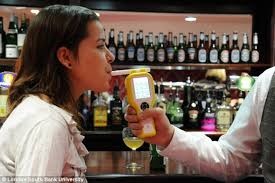
Collecting More Valid Data with ‘Bar Laboratories’
Technology is providing researchers with the tools to examine substance-use in new and exciting ways. Research can now be conducted in settings which mimic real-life, providing us with data that more accurately reflects how people might behave in everyday life.
An excellent example of this new type of data collection method is the ‘bar laboratory’. A ‘bar lab’ is a bar or pub setting replicated within a controlled laboratory. The participant walking through the door to bar lab (located in a University building) could be mistaken for thinking they just stepped into their local pub. From the tacky velvet wallpaper to the reclaimed stools and pub bar complete with dents and scratches, and the betting machine in the corner (rigged, of course, for experimental manipulation), the effect is surprising realistic. A person could easily forget they are in a laboratory and believe they are just having a pint with some friends.

Behind the scenes it is a different story. Cameras and microphones can record every detail, whilst the environment can be manipulated through lighting, music and background chatter. This allows researchers to collect data in an environment similar to where people usually find themselves drinking, and be able to control different factors of this environment to make scientific inferences. Furthermore, much alcohol research relies on participants having to remember what they drank the night before, or their intentions to drink in the future. This data is susceptible to bias through confabulation and misinterpretation. Gathering data through the bar lab allows researchers to measure the exact amounts of alcohol consumed.
Bar labs can be used for a wide range of experiments, giving us data on how we might better understand drinking behaviours and potentially reducing alcohol related harm. One such lab is located at London South Bank University (LSBU). Dr Daniel Frings, Senior Lecturer at LSBU, presented some of his work from the bar lab at a recent conference exploring ‘Emerging Research Methods’ within the addictions field, sponsored by the SSA.
The lab has been used to assess the effect of responsible drinking messages on participants’ alcohol consumption (1). In this study posters from an alcohol harm reduction media campaign were positioned around the bar, and the amount of alcohol consumed was measured (non-alcoholic, although participants believed it was real). The results were surprising, demonstrating that participants actually drank more alcohol when exposed to the alcohol campaign posters when compared to posters advertising academic services. One reason for this counterintuitive effect may be that posters targeting alcohol harm reduction actually act as cues to make alcohol more salient to participants, and consequently more likely to drink. This has major implications for the development of health campaigns for the future.
Collecting drinking data in a bar lab setting has several advantages, both ethical and practical, as bar lab studies are inexpensive and safe, and use controlled environments. The bar lab provides an exciting novel method to collect data, and, with additional bar labs being designed in other UK Universities, is likely to play a major role in future research.
by Joanna Milward, King’s College London
1. Moss AC, Albery IP, Dyer KR, Frings D, Humphreys K, Inkelaar T, et al. The effects of responsible drinking messages on attentional allocation and drinking behaviour. Addictive behaviors. 2015;44:94-101.
The opinions expressed in this post and podcast reflect the views of the author(s) and do not necessarily represent the opinions or official positions of the SSA.
The SSA does not endorse or guarantee the accuracy of the information in external sources or links and accepts no responsibility or liability for any consequences arising from the use of such information.